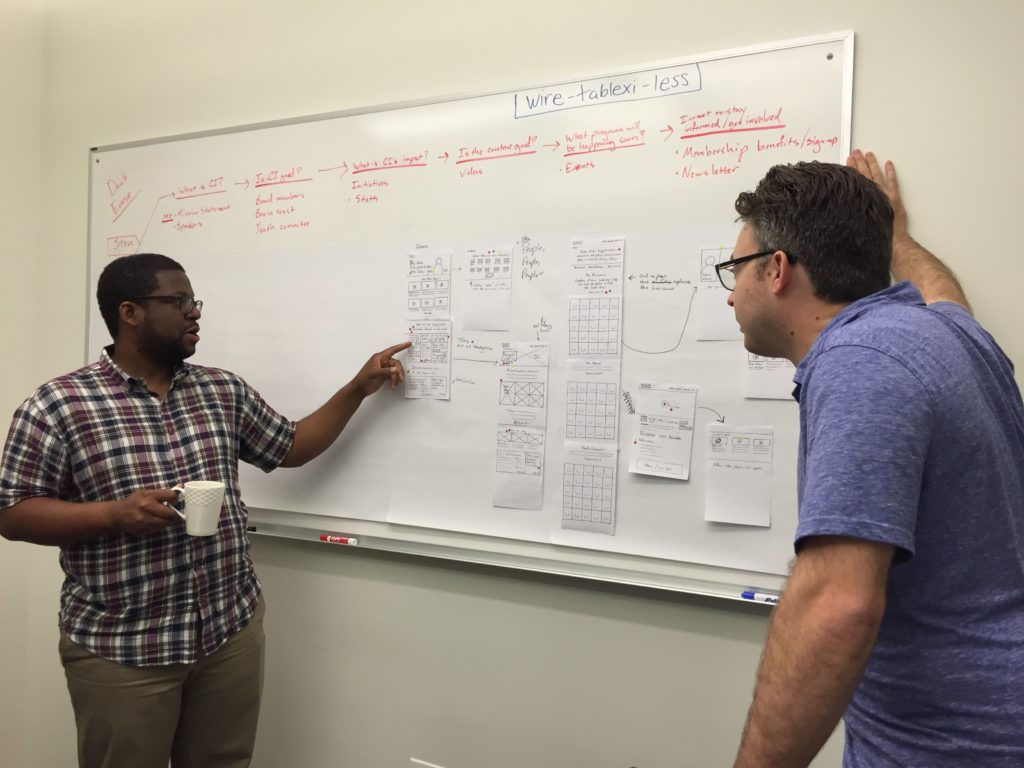
The Google Design Sprint Process, Explained
Entrepreneurship is everywhere these days. It can be hard to scroll through your news feed or turn on your TV without hearing about the next game-changing startups that’s aiming to disrupt an entire industry. But whether a company has just launched or has been around for decades, inefficient or clunky design and development processes can cause them to flounder.
Last year, Chicago Ideas found itself in need of a website update that matched the goals and needs of our organization. We turned to Chicago-based design and development firm Table XI, and they leveraged a relatively new process dubbed the “Google Design Sprint.” We spoke with the company’s COO Mark Rickmeier about how the process works, and how other companies and individuals can leverage it to build better products, platforms and workflows.
Broadly, can you define what a Design Sprint entails?

The high upfront cost of traditional design and development processes raise the stakes so high that no one can afford to be wrong. Because of the high costs, many teams don’t have room to try out big, bold, innovative ideas. Instead, they rely on tried and true techniques that are safe, but fail to excite their customers.
Google Design Sprints change that. The process, pioneered by Google investment arm GV, shrinks what’s normally a months-long development cycle to five intensive days. The first three days are spent learning about the company and developing ideas to solve a problem. The fourth is spent building a testable prototype, and the fifth is spent getting feedback from representative users.
How long have Design Sprints been around for?
GV only formalized its Design Sprint process a few months ago, when designer Jake Knapp and team published Sprint, but the designers at Google have been floating these ideas around for last three or four years.
Table XI used the Design Sprint approach in building Chicago Ideas’ new website. Can you walk me through how you approached that project in particular?
Absolutely! We’re really proud of the work our team did on the Chicago Ideas website. We’ve worked with Chicago Ideas for a number of years. We’ve built a number of things from ticketing systems to the marketing site. Last year, after early discussions with the Chicago Ideas team, we realized to approach the design from a fresh perspective. Chicago Ideas is about more than just a weeklong festival in the fall—it’s about spreading the Chicago school of thought to a wider audience.
To kick off the project, we started with a Design Sprint. However, our week started with a unique twist. Instead of focusing on the experience that event attendees would have during week of Chicago Ideas, we wanted to learn how we could design the best possible experience for thought leaders. This was a user group that hadn’t received as much attention during previous years.
By the end of the week, we learned a lot about that audience segment. More importantly, we learned a lot about the new vision of Chicago Ideas. The Design Sprint enabled our team to internalize the different perspectives from stakeholders inside of the organization and create a shared vision for the future of Chicago Ideas.
What are some other examples of a Design Sprint working successfully?
We’ve worked with a wide variety of clients to solve very different problems with Design Sprints. Our first Design Sprint was with a UK betting site. Online sports betting isn’t legalized in the US, but it is legal in many countries, including the UK. During the Design Sprint, the client wanted to explore how it could offer an odds comparison site that could differentiate it from it’s competitors.
In one of our more recent Design Sprints, we worked with a Houston-based University that wanted to understand how it help their students discover more leadership opportunities that are available. Although the problem seems simple enough, there are many hurdles to getting students to sign up for programs: many students don’t regularly use email or social networks; students tend to trust word-of-mouth from other students more than official marketing for programs; in this highly prestigious university, students must be cautious to not over-commit their time for fear of GPA slipping.
What differentiates a Design Sprint from other creative brainstorming approaches?
There are many processes for ideation and brainstorming out there. However, few processes combine discovery, rapid prototyping and customer research into a five-day timeframe.
The biggest differentiator for Design Sprints in our opinion is the focus on learning from your customers. We believe our number one job is to make products our client’s customers love. Without involving customers in the process, it’s difficult to know if you’re heading in the right direction.
Many processes generate ideas but fail to test them with customers. By putting something that looks real in front customers really quickly, we can learn a lot about the effectiveness of our ideas and our customer’s perceptions. Although testing with just a few users isn’t statistically significant, it provides us with directional clarity.
If I’m not a designer or a programmer, how can I leverage a Design Sprint technique?
Anyone can leverage the techniques used in Sprints. However, the most valuable lessons from Design Sprints are the philosophies it is based on:
- The biggest challenges require less time, not more
Time is a big factor in helping people to generate creative solutions. However, magic moments tend to happen when we’re up against true deadlines. By creating a real deadline, scheduling customers to test an idea, you can ensure your team is orientated towards the same goal.
- Individuals produce better solutions than teams
During creative processes, find ways to limit “groupthink.” Groupthink limits individual creativity, uniqueness and independent thinking by encouraging them to avoid raising controversial issues or alternative solutions. By creating opportunities for individuals to fully develop their own unique concepts, you can increase the quality of ideas you generate.
- You can test anything in 1 week by building a realistic façade
Building the real thing can take months of effort, only to learn that your customers don’t want it. However, low-fidelity prototypes can require users to fill-in the gaps with their imagination and lead to inconclusive findings. By making a “Goldilocks” prototype that’s just real enough, you can get the most useful insights from your customers in the shortest amount of time.
Do I have to be a designer in order to sketch and participate?
No, anyone can participate in Design Sprints and get a lot of value out of them. Many of the clients we’ve worked with are not in design and technology. Although many non-tech people are intimidated by the task of sketching next to designers and developers, we sometimes find that designers and developers don’t have the winning idea. Because designers and developers are so attuned to current industry practices, it can be hard to break out of the mold. Having different perspectives is critical in Design Sprints.
Will testing five people be enough? Is that statistically significant for results?
Our goal in Design Sprints isn’t to reach absolute certainty that our idea is the right one. For many products, you’d have to build the entire product to be absolutely certain that customers will use it. Design Sprints borrow from the ideas behind the Lean Startup movement. Instead of wasting money building the product or testing with thousands of people, we aim to learn as much as we can about the validity of our idea in shortest period of time.
The famed researcher Jakob Nielsen, of Nielsen Norman Group, discovered years ago that elaborate studies are often a waste of resources. To quote Nielsen, “The best results come from testing no more than five users and running as many small tests as you can afford.” We see Sprints as one of the many opportunities to validate product ideas.
How can I get a buy-in from leadership to try Design Sprints?
For many organizations, getting leadership onboard with Design Sprints is about conveying business value. Helping your organization understand the costs, risks and opportunities to your organization’s leaders is critical.
Since the time commitment is only one week, the risks of running a Design Sprint are pretty small. At worst, your team will come up with an idea that customers dislike. By only investing a week into the idea—instead of months—you’ll saved your organization a lot of money that they would have wasted pursuing the wrong idea.
One of the biggest costs associated with Design Sprints is the time of your team members. We believe Sprints work best with teams of five to seven people. Requiring that many people to focus on a single activity for an entire week can be costly. However, we’ve found that doing Design Sprints often helps teams make decisions that may have otherwise taken them months.
In terms of opportunity, Design Sprints have reshaped the way that many organizations approach design. Few processes enable organizations to rapidly generate ideas and learn from their customers in a single week. For many organizations Design Sprints could become the standard approach for operating.
What if I can’t get my senior stakeholder to participate for all five days of the sprint?
These workshops certainly require a time commitment from a leader in the organization to play the role of “the Decider.”
We know that it can be difficult for leaders to commit their time for an entire week. To make it easier for them to participate, we make accommodations for them to drop in and out of the Sprint. We require their presence on days one and three (when we’re making big decisions about the direction of the prototype). During the rest of the week, the decision maker can elect a proxy to represent them in discussion, if necessary.
What kind of problems is this process good for? When is this the right approach for a company?
Participating in a Product Design Workshop requires dedicating a small team to the work for five days. Given the investment, it’s right to ensure your business will get the maximum business value from the workshop.
In our experience, a Product Design Workshop is best used to solve big problems. For example:
- Defining new products or services
- Reimagining existing products or services
- Extending an existing experience to a new platform
- Injecting user experience design into an new product
- Improving user experience gaps (e.g. a high rate of cart abandonment)





